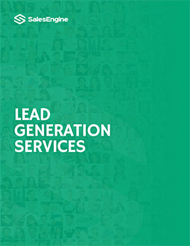Category:
7 Tips for Cold Email Marketing Success in 2018
| 0
Cold email marketing has become a goto solution for marketing and sales teams everywhere. These campaigns offer scalability, automation, and a wide variety of valuable data that can be used to test new ideas, optimize performance, and generate more leads for sales.
These 7 tips will help equip you with the mindset and tactics that can deliver and sustain a high-performing cold email campaign.
Make Each Email a Valuable Transaction
People are more likely to interact and engage with something that they find valuable, interesting, or insightful.
To a prospect, value isn’t just a pitch. It needs to be intriguing, useful, or relevant to their company and role as a professional. At the end of the day, prospects are humans.
Value gives purpose to a conversation, makes a chat worthwhile to the prospect, and helps build rapport and thought leadership.
There are many creative ways you can add value. Sharing an article, a relevant statistic, a new industry topic, or problems and solutions they care about can spark interest and pave the way to a meaningful conversation.
High Reply Rates Aren’t Always a Good Thing
Cold emails cannot be reliably improved using data analysis alone. It’s necessary to use both qualitative and quantitative insights when optimizing cold email marketing performance, because it gives you a deeper understanding of how and why to make improvements.
An email can reach a top-performing reply rate for many reasons, including negative drivers like negative comments from irritated recipients, incorrect targeting, or confusion.
On the flipside, an email might be very successful at starting meaningful conversations that translate to deals, even though its reply rate might be seen as low-performing.
Looking at the quantity of replies in a cold email campaign without reviewing the context of the responses can distort testing and optimization by overlooking key drivers of performance.
When using data to optimize campaign performance, always ask the question “why” to help uncover the bigger picture.
If a new topic caused a spike in the reply rate, discover context around why, talk with sales about how the topic resonates with customers, and use this information together to identify relevant improvements that maximizes the success of your cold emails beyond just a metric.
Lead Nurturing Works
Cold email marketing campaigns work well in starting conversations with prospects. However, most prospects entering your pipeline will not be at the bottom of the sales funnel and ready to buy.
Therefore, cold email efforts miss out on a lot of value and opportunity if there isn’t a process in place for what to do after a lead enters your pipeline. The solution is a game plan for how to nurture leads into closed deals.
Having a lead nurturing process in place helps make the most out of the leads generated by your cold email campaign. With up to 79% of marketing leads never converting to sales (Marketing Sherpa), nurturing leads is paramount to get the most value from your sales pipeline and increase the ROI of your cold email marketing efforts.
Use Industry and Employee Role Terminology
One way to produce better results with your cold emails is by including terminology that resonates and is relevant to your target audience.
Using words and phrases specific to your target segment helps you stand out amongst other cold emails by making the email more relevant, relatable, and authoritative.
To do this, build a list of common terminology and phrases used by your target audience by doing some research.
Take a quick look at industry forums, company websites, and LinkedIn profiles of people at companies in your target roles for a goldmine of information that can be used for your cold emails.
Make Subject Lines Relevant
One of the oldest tricks in the cold email marketing playbook involves “hooking” people to open an email with an attention-capturing subject line. While this trick might increase open rates, it doesn’t mean that it brings any value to you or the prospect.
When subject lines are misleading or disconnected from the body copy, it can cause leads to feel tricked and can damage their view of the company sending the email.
To prevent this from happening, keep subject lines aligned with your email copy so that you capture the attention of prospects for the right reason.
Use KPIs to track and improve campaign performance
It’s a valuable best practice to set up Key Performance Indicators (KPIs) and consistently track the success of your cold emails, because this enables you to benchmark progress and improve over time.
A periodic review of these KPIs can help you identify where changes need to be made while giving you the ability to test improvements and see how it affects performance. Gather data, review the results, and draw hypotheses from these metrics to uncover potential improvements.
The right metrics to use in cold email KPIs will depend on your company’s particular needs, goals, and limitations. In general, it’s best to choose metrics that have an impact on the performance of both the cold email campaign and sales performance as a whole.
Examples of KPIs for cold email marketing can include metrics such as open rate, reply rate, meeting conversion rate, or the total impact it has on revenue.
Make Call-to-Actions Easy to Answer
A call-to-action (CTA) is a clear next step you request from a prospect within the cold email in the attempt to keep the conversation moving forward. CTAs are critical because it’s asking the prospect to commit their own time or energy into addressing your request.
Before prospects decide to respond to your ask, they need to first evaluate you, your business, and the potential value of committing time to your request. Despite how valuable you or your CTA might be to prospects, asking for too much can cause prospects to not respond at all.
While it’s great to ask for big commitments like meetings, it’s risky to ask for them in every email you send. With prospects receiving your emails at various stages of the buying cycle, it’s essential to change up CTAs so you have the chance to build relationships with those who aren’t ready for a meeting.
Rather than ask for the meeting, try easier requests that are simple and less time-consuming for the prospect. For example, try asking a relevant question related to a potential pain point.
These types of CTAs can be more effective at starting conversations and can lay the foundation for a relationship moving forward. It also creates opportunities to start adding value for the prospect and nurturing the relationship without requiring a lot of their time or energy.
Cold Email Marketing is Here to Stay
While the sales and marketing strategies of tomorrow will evolve, cold email marketing will continue to make an impact on B2B companies as a scalable engine for building sales pipeline. Through the effective use of cold email, your company can drive more predictable revenue growth and help get the meetings and demos salespeople need to crush quota.



